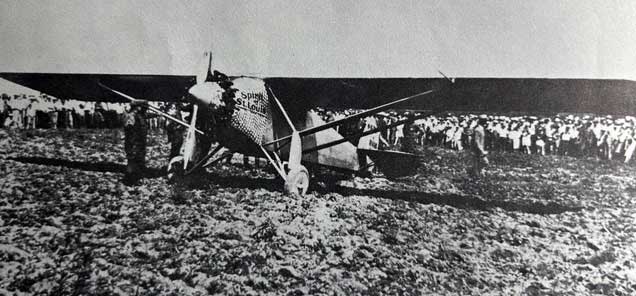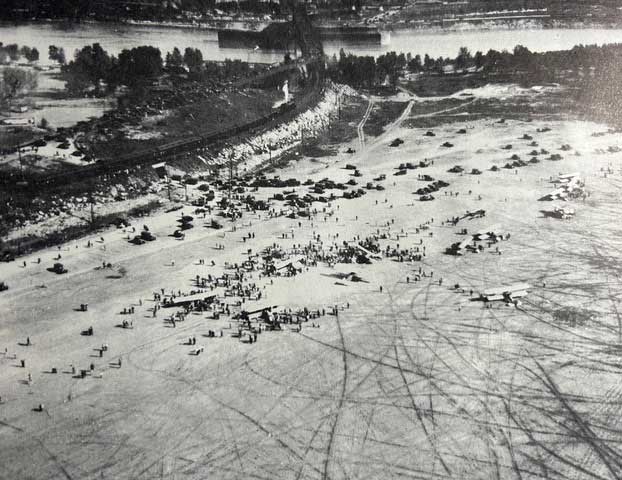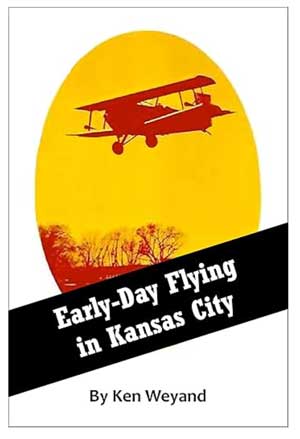Kansas City’s early-day airports helped make flying history
May 2025
Vintage Discoveries
Kansas City’s early-day airports helped make flying history
by Ken Weyand
Operating in an era when airplanes were a novelty, pilots navigated using “dead reckoning, and a good landing was “any landing you could walk away from,” Kansas City’s early-day airports saw a variety of aviation history being made.
Greater Kansas Citians saw their first flights in December 1909, when Charles K. Hamilton, a member of the Curtiss aviation team, flew exhibition flights on an improvised field in Overland Park, KS. The flights were sponsored by the Overland Park Athletic Club and covered more than a mile at an altitude of 500 feet. Visitors made their way to the field using the Strang Electric Line, an interurban trolley.
The area’s first airport was Keller Strasse Field, using a portion of Albert C. Reed’s farm, east of present-day 87th and Holmes Road. Its early customers included E.L. Sloniger and Blaine Tuxhorn, two of the area’s first pilots. Sloniger flew for a Kansas City-to-Wichita Airline, formed in 1925, that lasted for three months. Tuxhorn operated his own airline between Kansas City and St. Joseph. In 1926, he even built his own airplane for the route.
Richards Field, located south of Hwy. 50 near present-day Raytown, was little more than a pasture, but attracted a variety of pilots, and National Air Transport, Kansas City’s first major airline. Kansas City’s first airmail service began May 12, 1926, when a Curtiss “Carrier Pigeon” landed at the airport.
Kansas City Municipal Airport, a large field located in just north of the Missouri River in Clay County, was dedicated on August 17, 1927, by Charles Lindbergh, three months after his solo flight to Paris. Lindbergh was scouting the area as a possible location for T.A.T. Airlines, later to become T.W.A. In a speech, Lindbergh praised the area. A recording of it encouraged the company to establish Kansas City as its headquarters.

Lindbergh’s “Spirit of St. Louis” at Municipal Airport in 1927 (Ken Weyand collection)

Early-day “fly-in” at Municipal Airport (Ken Weyand collection)
The airport’s name was changed to Kansas City Downtown Airport in 1977 and renamed the Charles B. Wheeler Downtown Airport in 2002 in honor of the former mayor of Kansas City.
Fairfax Airport, across the river in Kansas City, Kansas, began life as “Sweeney Airport. Several airplane manufacturers test-flew airplanes and made their headquarters at the airport, which eventually boasted a 7,200-foot north-south paved runway. The airport eventually closed and was converted to industrial sites.
Many other small fields served aviation needs in the early days of flying. One was called “Police Airport,” dating at least to 1923. It was essentially a hayfield located in North Kansas City east of Burlington Avenue, where a retail complex that included the old Dolgin’s store would be built. According to the book “North Kansas City, A Bridge to the Past,” the field included a “hay barn and an old metal shed which was used as a hangar.”
Ace Reynolds, a barnstormer, test pilot, and an instructor at the Art Goebel School of Flying at nearby Municipal Airport, recalled taking off at Municipal one noon and landing at Rugel’s (a large drive-in restaurant on Burlington Avenue.) “They ran an ad in a newspaper after than, reading ‘Drive-In, Fly-In Service.’ The CAA made short work of that, though.”
For more Kansas City-area aviation history, read Ken’s E-book, “Early-Day Flying in Kansas City.” $2.99 from Amazon.com.

Ken Weyand is the original owner/publisher of Discover Vintage America, founded in July 1973 under the name of Discover North.
Ken Weyand can be contacted at kweyand1@kc.rr.com Ken is self-publishing a series of non-fiction E-books. Go to www.smashwords.com and enter Ken Weyand in the search box.
‘Single Tree’ was part of old-time farming
November 2021Vintage Discoveries‘Single Tree’ was part of old-time farmingby Ken Weyand Early in the 1940s, after years of “horse-farming,” my dad bought a tractor and sold his team of draft horses. Soon after that, much of the horse-drawn equipment was sold,...
Visiting Chicago’s Century of Progress Exposition, 1934
September 2019Vintage DiscoveriesVisiting Chicago's Century of Progress Exposition, 1934by Ken Weyand On Sept. 16, 1934, my mother, Mabel Weyand, and her parents, Charles and Carrie Forrester, boarded a train at Medill, MO, for Chicago to attend the Century of...
Flying ‘back in time’ in a vintage biplane
~ October 2018 / Traveling with Ken ~Vintage DiscoveriesFlying 'back in time' in a vintage biplane ~ by Ken Weyand ~ Flying in an open-cockpit biplane is a forgotten part of our history. It was an era when pilots flew "tail-dragger" aircraft from grass...
Only ghosts remain in Arkansas mining town
~ December 2017 / Traveling with Ken ~Vintage DiscoveriesOnly ghosts remain in Arkansas mining town ~ by Ken Weyand ~ Unlike the many pop-ulated hamlets that dot the Ozarks countryside, the old mining town of Rush is a true ghost town. Located 16 miles...
Thomas Hart Benton home preserves painter’s spirit
~ July 2017 / Traveling with Ken ~Vintage DiscoveriesThomas Hart Benton home preserves painter's spirit ~ by Ken Weyand ~ The Thomas Hart Benton Home and Studio State Historic Site at 3616 Belleview in Kansas City, MO, looks as if the artist might walk in...
Will Rogers’ birthplace, memorial museum worth a visit
~ December 2016 / Traveling with Ken ~Vintage DiscoveriesWill Rogers' birthplace, memorial museum worth a visit ~ by Ken Weyand ~ One of the most famous Oklahoma natives to influence American culture was Will Rogers. Known as a “cowboy philosopher,”...
Eureka Springs: Victorian jewel in northwest Arkansas
~ June 2016 / Traveling with Ken ~Vintage DiscoveriesEureka Springs: Victorian jewel in northwest Arkansas ~ by Ken Weyand ~ Before there was a state called Arkansas, the mountain community now known as Eureka Springs was already attracting visitors....

